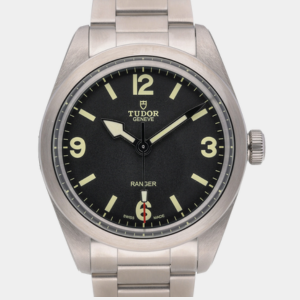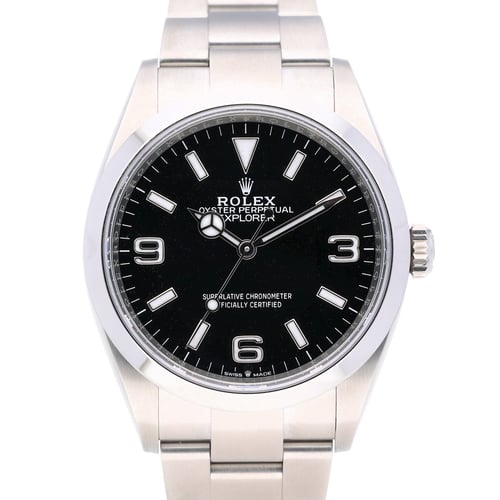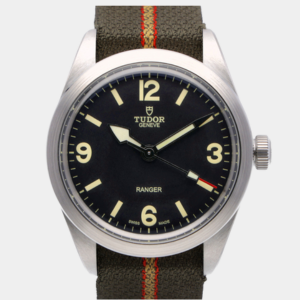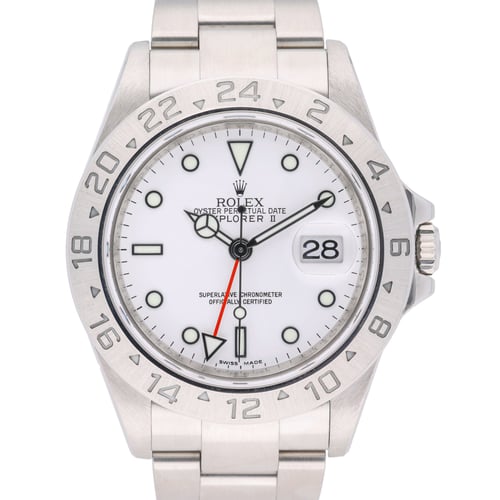There’s something undeniably romantic about a rugged field watch.
The simplicity. The legibility. The quiet confidence that doesn’t scream for attention but earns your respect with time and wear. It’s a design born from necessity, refined by decades of use in the real world. When it comes to this genre, two names often rise to the surface: the Tudor Ranger and the Rolex Explorer.
Both are icons in their own right. Both are tools born from adventure. And yet, despite the family ties, they couldn’t feel more different.
So which of these two watches makes the better companion for the modern explorer? Let’s take a closer look.

Before diving into the watches themselves, we need to talk about history - because with both the Tudor Ranger and the Rolex Explorer, history is the heartbeat.
The Rolex Explorer was born in 1953, inspired by Rolex’s involvement in the British expedition that summited Mount Everest. It was designed to be tough, reliable, and supremely legible. Over the years, the Explorer has been the understated adventurer’s choice - worn by mountaineers, scientists, and those who wanted a Rolex that didn’t feel like a Rolex.
The Tudor Ranger has its own lineage, though it’s one that Tudor has only recently leaned into more heavily. The first “Ranger” models date back to the 1960s, but they weren’t clearly separated from Tudor’s Oyster line at the time. The modern interpretation, reintroduced in 2022 as the ref. 79950, leans heavily into the vintage aesthetic - a callback to tool watches of the past, complete with aged lume and brushed steel. It’s more retro, more niche, and intentionally so.
While both watches were built with exploration in mind, their approach to storytelling - and design - is vastly different.
Let’s start with the wrist feel.
The current Rolex Explorer, reference 124270, returned to its original 36mm case size in 2021, much to the delight of traditionalists. At 36mm wide and just under 12mm thick, it’s compact, comfortable, and incredibly versatile. You can wear it in the mountains or under a cuff at dinner. The Oystersteel case is brushed on the lugs and polished on the flanks, giving it a clean, almost dressy feel.
The Tudor Ranger, on the other hand, comes in at 39mm with a fully brushed case and a slab-sided profile. It’s not a thick watch at 12mm, but it wears a bit larger than the Explorer due to its flat caseback and wider dial opening. If the Explorer feels refined and discreet, the Ranger feels more industrial - purpose-built and not trying to hide it.
Both watches are comfortable, but the Ranger’s toolish presence gives it a bit more wrist attitude. The Explorer is a chameleon; the Ranger is unapologetically a field watch.


The dials of both watches speak the same language but with different accents.
The Explorer features the hallmark 3-6-9 layout, white gold surrounds on the hour markers, and crisp, white Chromalight lume that glows icy blue in the dark. The Mercedes-style hands are a Rolex staple, and the dial is inky black and glossy. It’s clean. Precise. Modern. And very Rolex.
The Ranger, by contrast, embraces its vintage leanings. The dial is matte black, the markers are printed and filled with beige-toned lume, and the Arabic numerals (3, 6, 9, 12) feel lifted straight from a 1960s field watch. The hands are simple batons, no Mercedes shapes here. The entire dial exudes a retro ruggedness that the Explorer intentionally eschews.
In short: the Explorer is elegant in its legibility. The Ranger is warm in its nostalgia.
Both watches are equipped with robust in-house automatic movements that deliver impressive performance.
The Rolex features a calibre developed entirely in-house, known for incorporating advanced technology such as the Chronergy escapement and a paramagnetic blue Parachrom hairspring. It boasts a 70-hour power reserve and is regulated to Superlative Chronometer standards, ensuring precision of ±2 seconds per day - well beyond standard COSC criteria.
Tudor’s movement, on the other hand, is COSC-certified and offers the same 70-hour power reserve. While it doesn’t showcase the same level of technical innovation or refinement as its sibling, it’s impressively rugged, accurate, and built for durability. Its development involved collaboration with Kenissi, a movement manufacturer partially owned by Tudor, making it an in-house effort - albeit with shared resources.
In practical terms, both calibres are reliable workhorses capable of withstanding the rigours of daily life. The differences, while notable on paper, may go unnoticed by most wearers in real-world use.

Both watches come on excellent steel bracelets.
The Explorer offers the classic Oyster bracelet, with solid links and the Oysterlock clasp. The comfort and refinement here are world-class. No on-the-fly adjustment, but it does feature the Easylink system, which allows for a 5mm extension with a simple fold-out link.
The Ranger comes with Tudor’s newer T-fit clasp, a brilliant micro-adjust system that offers 8mm of tool-less adjustment. The bracelet is fully brushed, in keeping with the utilitarian theme, and the clasp is sturdy and well-machined. The Ranger also offers fabric and hybrid strap options - something Rolex doesn’t provide.
In terms of finishing, the Explorer edges ahead with slightly crisper transitions and polish, but the Ranger’s bracelet is arguably more practical.
The Explorer is pure classicism - clean lines, quiet confidence, and a design honed over decades of real-world use and refinement. It’s the kind of watch that fits as easily under a cuffed Oxford shirt as it does peeking out from a Gore-Tex sleeve. A flex, yes - but a subtle one. It’s Rolex doing what Rolex does best: purpose-built luxury without the flash.
The Ranger, by contrast, hits different. There’s a rawness to it. A kind of utilitarian charm that nods to military-issue field watches of the past, but without falling into retro cosplay. It’s tough, no-nonsense, and wears its heritage lightly. It’s not trying to outshine its big brother - and that’s exactly why it works. This is a watch for those who appreciate understatement, but aren’t afraid to get it dirty.
At the end of the day, it’s less about spec sheets and more about identity.
Are you the refined minimalist who appreciates Rolex legacy and precision engineering? Or the independent spirit who'd rather take the road less travelled with a Tudor built like a tank?
Either way, both watches are more than capable - and each one tells a story. The question is: which one’s yours?
At BQ Watches, we can help you chose the perfect pre-owned Rolex or Tudor watches. If you don’t spot your ideal timepiece in our current inventory, don’t hesitate to reach out to our team. With our extensive sourcing services, we’re dedicated to helping you track down your dream watch.
At BQ Watches, we’re dedicated to helping you find the perfect pre-owned luxury watch. Our curated collection features all the leading brands, available to browse online at your convenience. Prefer a more personal experience? Visit our luxury showroom, where our knowledgeable team will be delighted to guide you in choosing the ideal timepiece.